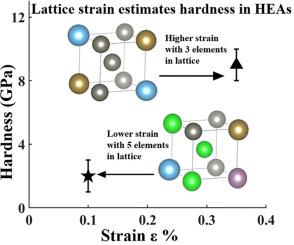Materials Characterization ( IF 4.8 ) Pub Date : 2021-01-06 , DOI: 10.1016/j.matchar.2021.110877 Ankit Roy , Praveen Sreeramagiri , Tomas Babuska , Brandon Krick , Pratik K. Ray , Ganesh Balasubramanian

|
Over the past decade, select high-entropy alloys (HEAs) have exhibited excellent structural properties, even at high temperatures, outperforming conventional alloys in some cases. Intriguingly, some reports in the literature suggest that HEA properties may be enhanced by increasing the number of elements, while another school of thought negates this notion and suggests that there is no clear dependence of mechanical properties on number of elements. We further examine this question in the context of a quinary refractory alloy system (MoTaTiWZr) and scrutinize whether number of elements in a HEA positively impact its mechanical properties. The present work showcases that certain equiatomic low- and medium- entropy alloys can exhibit superior structural properties (hardness, Young's modulus) relative to their higher-entropy counterparts composed of the same family of elements. Evidently, incorporating a higher number of constituent elements does not guarantee enhanced structural properties. Using a synergy of experimental measurements, complementary microscopic characterization and materials theory, we conclusively demonstrate that the intrinsic lattice distortion and cohesive energies are the predominant strengthening mechanisms that are reflected as high hardness and Young’s moduli of single-phase multicomponent alloys investigated in this work. Severe lattice distortion is one of the core effects of HEAs which imparts excellent room temperature structural properties and is generated by mixing multiple atom types. Likewise, a higher cohesive energy between the atoms in a lattice requires greater shear stresses to break the metallic bonds that increases the stiffness. An alloy with lower number of elements may intrinsically possess a higher cohesive energy than one with a higher number of elements within the same series, thereby outperforming the higher-entropy alloy on the structural properties.
中文翻译:

晶格畸变作为高熵合金固溶强化的估计
在过去的十年中,即使在高温下,精选的高熵合金(HEA)也表现出出色的结构性能,在某些情况下优于常规合金。有趣的是,文献中的一些报告表明,可通过增加元素数量来增强HEA特性,而另一种学派则否定了这一观点,并暗示机械特性对元素数量没有明确的依赖性。我们在五元耐火合金体系(MoTaTiWZr)的背景下进一步研究了这个问题,并仔细研究了HEA中的元素数量是否对其机械性能产生积极影响。本工作表明,某些等原子的低熵和中熵合金可以表现出优异的结构性能(硬度,s模数)相对于由相同元素族组成的较高熵的对应物。显然,并入更多的组成元素并不能保证增强的结构性能。利用实验测量,互补的微观表征和材料理论的协同作用,我们最终证明了本征晶格畸变和内聚能是主要的强化机制,反映为这项工作中研究的单相多组分合金的高硬度和杨氏模量。严重的晶格畸变是HEA的核心作用之一,它具有出色的室温结构特性,并且是通过混合多种原子类型产生的。同样 晶格中原子之间较高的内聚能需要较大的剪切应力才能破坏金属键,从而增加刚度。与相同系列中元素数量较多的合金相比,元素数量较少的合金固有地具有更高的内聚能,从而在结构性能上优于高熵合金。











































 京公网安备 11010802027423号
京公网安备 11010802027423号